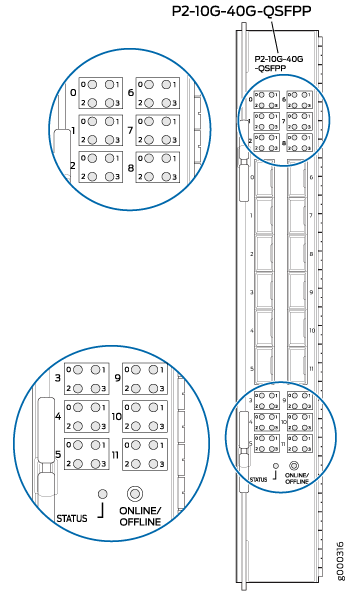10-Gigabit Ethernet/40-Gigabit Ethernet LAN/WAN OTN PIC with QSFP+ (PTX Series)

Software Release
PTX3000: Junos OS Release 15.1F6, Junos OS Release 16.1R2 and later, Junos OS Release 17.1R1 and later
PTX5000: Junos OS Release 14.1R2 and later
For information about which FPCs support these PICs, see PTX Series PIC/FPC Compatibility.
Hardware Features
Twelve ports (0 through 11) configurable as either 10-Gigabit Ethernet ports (in LAN, WAN, or OTU2) or 40-Gigabit Ethernet ports (in Ethernet or OTU3).
Note:The PIC supports either 10-Gigabit Ethernet or 40-Gigabit Ethernet ports. You cannot configure both 10-Gigabit Ethernet and 40-Gigabit Ethernet ports on the same PIC. You can, however, have PICs with 10-Gigabit Ethernet and 40-Gigabit Ethernet ports in the same FPC.
Model number: P2-10G-40G-QSFPP
Name in the CLI:
48x10G/12x40G(LWO)QSFP+Independent per-port configuration of:
LAN-PHY, WAN-PHY, or OTN framing for ports configured in 10-Gigabit Ethernet mode
LAN/WAN or OTN framing for 40-Gigabit Ethernet mode
Power requirements:
10-Gigabit Ethernet LAN/WAN mode (with QSFP+ transceivers on all ports)—9.09 A @–12.1 V (110 W)
40-Gigabit Ethernet LAN mode (with QSFP+ on all ports)—8.26 A @–12.1 V (100 W)
High-performance throughput:
10-Gigabit Ethernet LAN mode at 10.3 Gbps
10-Gigabit Ethernet WAN mode at 9.9 Gbps
40-Gigabit Ethernet LAN mode at 41.2 Gbps (10.3 Gbps per lane)
Configurable modes:
LAN-PHY—10-Gigabit Ethernet and 40-Gigabit Ethernet
WAN-PHY—10-Gigabit Ethernet
Full-duplex mode
Large maximum transmission units (MTUs): up to 9192 bytes
Software Features
Table 1 shows the first supported Junos OS release for each software feature.
Software Feature |
PTX3000 First Supported Junos OS Release |
PTX5000 First Supported Junos OS Release |
|---|---|---|
Flexible-ethernet-services encapsulation |
15.1F6 16.1R2 17.1R1 |
14.1R2 |
Flexible VLAN tagging |
15.1F6 16.1R2 17.1R1 |
14.1R2 |
IFINFO / IFMON |
15.1F6 16.1R2 17.1R1 |
14.1R2 |
IEEE 802.1 ag OAM |
15.1F6 16.1R2 17.1R1 |
14.1R2 |
IEEE 802.3 ah OAM |
15.1F6 16.1R2 17.1R1 |
14.1R2 |
IEEE 802.3ad link aggregation |
15.1F6 16.1R2 17.1R1 |
14.1R2 |
Interrupt-driven link-down detection for MPLS FRR |
15.1F6 16.1R2 17.1R1 |
14.1R2 |
MAC accounting per logical interface for source addresses |
15.1F6 16.1R2 17.1R1 |
14.1R2 |
MAC filter per port for destination addresses and source addresses |
15.1F6 16.1R2 17.1R1 |
14.1R2 |
MAC filter per logical interface for source addresses |
15.1F6 16.1R2 17.1R1 |
14.1R2 |
SNMP |
15.1F6 16.1R2 17.1R1 |
14.1R2 |
Up to 8000 logical interfaces share across all ports on a single Packet Forwarding Engine |
15.1F6 16.1R2 17.1R1 |
14.1R2 |
Cables and Connectors
You can use the Hardware Compatibility Tool to find information about the pluggable transceivers supported on your Juniper Networks device.
LEDs
The STATUS LED is located next to the ONLINE/OFFLINE button. The port LEDs are grouped into 12 and each group has four LEDs labeled 0, 1, 2, and 3. The groups have labels 0 through 11. The LEDs located next to each port indicate the link, status, and alarms, if any. Table 2 describes the functions of these LEDs.
If the PIC is configured for 40-Gigabit Ethernet, only the LED labeled 0 in a group of LEDs is lit and if the PIC is configured for 10-Gigabit Ethernet, then all four LEDs in a group are lit. You can use the following command to change the mode:
[edit chassis]
user@host# set fpc fpc-slot
pic pic-slot pic-mode (10G | 40G)
Label |
Color |
State |
Description |
|---|---|---|---|
STATUS |
Green |
On steadily |
PIC is online with no alarms or failures. |
Yellow |
On steadily |
PIC is initializing. |
|
Red |
On steadily |
PIC has an error or failure. |
|
– |
Off |
PIC is offline and safe to remove from the router. |
|
LEDs 0 through 11 and each group of LEDs are labeled 0, 1, 2, and 3. |
Green |
On steadily |
Port is online with no alarms or errors, and the link is up |
Blinking |
There is link activity on the port. |
||
Red |
On steadily |
Port is on but the link is down, and the port has detected a failure. |
|
– |
Off |
Port is off or not enabled. |
